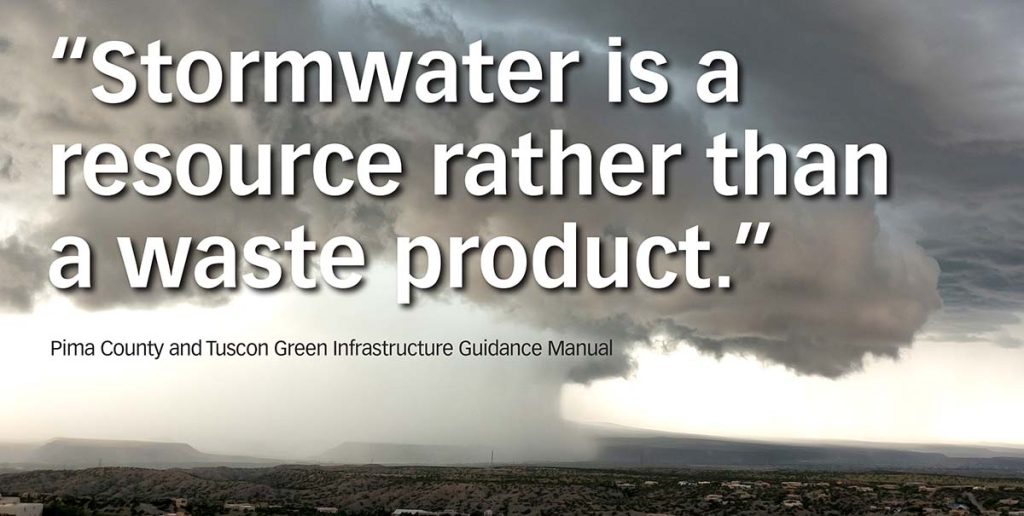
“Green Infrastructure is a new term for an ancient idea. For millennia, humans have known that survival depends on effective management of freshwater resources. Working with natural water systems yields healthy crops, plentiful hunting and fishing, flood-free homes, and clean drinking water. However, the balance was disrupted by nineteenth century industrial revolution ideology which sought control of systems (including water systems) for maximum efficiency, commodification, and profit.
Particularly after the Second World War, the quest for efficiency and control led to the containment of stormwater in concrete pipes and channels. This approach concentrates pollutants and increases flow velocity, both of which cause significant damage to natural waterways… Green Stormwater Infrastructure (GSI) practices seek to reconnect water to the land, use natural systems to filter pollutants and decrease velocity, and create a healthy environment for humans and other species.” (1)
Practices to manage stormwater differ, from areas of high rainfall to those with little such as the arid to semiarid mid Rio Grande. Tucson is a comparable municipal area which has adopted a GSI approach to water management. This began as grassroots actions over 20 years ago and is now driving land development policies to use water as close to where it falls as possible to support the natural landscape. GSI practices may be more important in arid and semiarid areas according to research modelling done in Salt Lake City.
The Environmental Protection Agency (EPA) is now requiring certain features of GSI in their permitting. However, in the mid Rio Grande, there are over 20 agencies overseeing and providing permits for various aspects of water quality and quantity (Federal, State, regional, municipal, and tribal). This is a major barrier to an overall plan. Then again, since this region has varied geographical features and ‘prior water rights,’ it allows decisions to be made by smaller populations in unique areas of our watershed.
The EPA Hydrologic Cycle purports that if GSI practices using trees and ground covers are in place, runoff is reduced to 10%. Compare this to 55% runoff in areas with mostly impermeable surfaces like pavement. When this water resource goes down the storm sewer, our community’s potable water use continues to be higher than it needs to be. We are, in essence, wasting drinking water.
What can we do in our yards, neighborhoods, and city-wide?
Houle (1) gives us these practices which can help reduce our use of potable water:
- Allow water to collect and infiltrate where it falls by mulching any bare ground, making berms and swales, and building shallow basins ( maximum 18″ depth which can drain in four days.) This will increase soil moisture, help plants live, and let stormwater penetrate our soil and recharge groundwater.
- Plant drought-adapted trees, shrubs and grasses. This will keep the ground temperature cooler and help decrease the urban heat island effect. There is an extensive list of trees for this area on The Nature Conservancy site, “Climate Ready Trees for the Next Hundred Years.”
- Use soft materials to manage runoff, such as shredded wood mulch. This practice slows runoff and steers us away from concrete and asphalt. We can build infrastructure using rocks, soil, and plants. These materials are less expensive and easier to construct.
Tuscon’s development of GSI policies and practices began with interested people in small groups. Right now in Albuquerque there are a couple of adjacent neighborhoods (Mile High and Pueblo Alto) looking at possibilities for their area to control standing water as well as make their neighborhood more enjoyable for the residents. The City of Rio Rancho has published brochures to educate residents: “10 Things You Can Do to Prevent Stormwater Runoff and Pollution” and ” How to Make your Home the Solution to Runoff Pollution.” Bernalillo County, in conjunction with others in our community, has established a demonstration site at the Gutierrez Hubbell House of stormwater management.
ACTIONS: Look for places that GSI practices can be applied in your yard, nearby alleys, and vacant lots. Talk with your neighborhood association about GSI possibilities and organize a interest group. Can unnecessary asphalt or concrete be removed from your neighborhood?
(1) “For the Health of the Mid Rio Grande Valley: A Proposal for Green Storm Water Infrastructure.” Tess Houle, thesis. University of New Mexico


Thank you for the summary on NM law governing the allocation of water and the informative article o Green infrastructures. I appreciate all the research that goes into the articles published in Middle Grande Times. Blessings for 2022